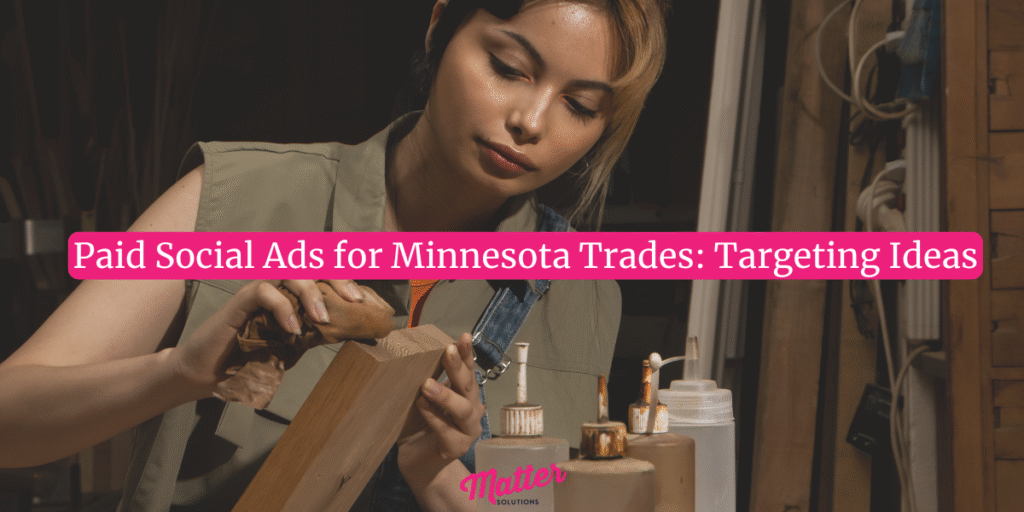Facebook and Instagram ads let Minnesota HVAC contractors and trade businesses target the exact customers they need. Homeowners planning furnace replacements scroll through these platforms daily. So do property managers looking for maintenance partners. And with paid social campaigns, you can control who sees your ads and how much you spend.
Even experienced agencies like www.mattersolutions.com now include paid social in their digital marketing strategy because it fills the gaps Google Ads can’t reach. Plus, with the targeting ability on these platforms, you can create campaigns for specific neighbourhoods, job titles, and interests.
We’ll break down everything you need to know about paid social Minnesota campaigns in the sections below, so stick around to learn how to build your first paid ad for success.
Why Paid Social Minnesota Works for Trade Businesses
Paid social advertising on Facebook and Instagram lets Minnesota trade businesses reach homeowners exactly when they need HVAC repairs, electrical work, or plumbing services.
The platform doesn’t wait for people to search; instead, it puts your business in front of them while they’re planning projects or scrolling through renovation ideas.

With over 3 billion people using Facebook each month, chances are, a good chunk of them live right in your service area. The ability to reach this many potential customers gives you an edge over competitors who are stuck on Google Ads alone.
Also, you will have full control over your daily budget while testing which audiences actually respond. Some contractors spend $50 per day testing homeowners in specific ZIP codes, while others focus on property managers.
Here’s a quick tip: visual ads work better than text. So, when a homeowner sees your team installing a furnace in a house that looks like theirs, it quickly builds trust. We’ve watched too many contractors burn through budgets on the wrong audiences.
Ultimately, the difference between wasted spending and reliable leads comes down to your targeting strategy.
Target Homeowners Planning Seasonal Projects
Now that you understand why paid social performs well, here’s your best audience: homeowners planning seasonal upgrades. Minnesota’s weather creates predictable patterns like furnaces failing in October and air conditioners dying in June.
Experienced contractors target these homeowners before the emergency happens. Let’s take a closer look at those statistics:
Paid Social Minnesota Tactics for Spring and Fall
Spring and fall bring massive surges in furnace replacements, AC installations, and home renovation searches. Homeowners aged 35-65 who own properties in your service area make up your primary target. You can narrow this down further by household income, home value, or even the age of their house.
Drawing from our experience running campaigns for Minnesota HVAC contractors, targeting homeowners in properties built before 2000 works exceptionally well. These homes need system upgrades more frequently. The older the home, the higher the likelihood of needing your services within the next 12 months.
Digital Marketing Through Life Event Targeting
Recent home purchases mean they need immediate service. New homeowners want HVAC assessments, electrical inspections, and plumbing checks within their first 90 days. And Facebook lets you target people who recently moved or bought a home.
You’re reaching them during the honeymoon phase when they’re actually willing to spend money fixing things. They also haven’t built relationships with local contractors yet, so your ad becomes their first point of contact.
Reach Commercial Property Managers and Builders
The best part about B2B targeting is that you can reach decision-makers who control multiple properties and ongoing contracts. Property managers oversee apartment buildings, office complexes, and commercial spaces that need regular HVAC maintenance, electrical repairs, and plumbing services. So, one good relationship with a property manager can generate steady work for years.
You should also target job titles like facilities manager, property manager, and construction project manager on both LinkedIn and Facebook. Facebook’s targeting lets you reach these professionals based on where they work, their role, and which industry they’re in. The cost per lead runs cheaper than LinkedIn while still reaching quality decision-makers.
Builders who are planning new developments need electrical, plumbing, and HVAC partners for large-scale projects, and they usually aren’t one-time jobs. Simply get on a builder’s preferred vendor list, and you’ll see repeated work across multiple projects. And target people who follow construction industry pages, building supply companies, or local development news.
The bottom line: focus your ad spend on the specific roles that actually sign contracts and approve invoices.
Geographic Targeting Within Minnesota Markets
Once you identify your audience type, geographic targeting helps you focus your budget on the right Minnesota markets. Because not every neighbourhood needs the same message or the same service radius.
Metro vs. Rural Targeting Differences:
| Factor | Twin Cities Metro | Rural Minnesota |
| Radius | 10-15 miles | 30-50 miles |
| Messaging | Fast response times, premium services | Reliable local service, competitive price |
| Peak Season | Year-round demand | Heavy winter focus |
Target specific ZIP codes in Minneapolis, St. Paul, Duluth, and Rochester for concentrated coverage. And to be honest, a homeowner in Edina will expect different service than someone in Bemidji, and your ad copy needs to reflect those differences.
For example, rural Minnesota towns need messaging that emphasises reliability and local presence, while Twin Cities metro homeowners care more about speed and premium options.
Our tests revealed that tightening your geographic radius during winter months improves conversion rates by nearly 40%. Customers prefer nearby contractors during emergencies, especially when temperatures drop below zero and furnaces fail at midnight.
Pro tip: Stay within a 15-mile radius for metro campaigns. Expand to 30-50 miles for rural areas where customers expect longer drive times anyway.
Building Your Marketing Strategy with Interest Targeting
Did you know, Facebook’s interest targeting lets you reach specific audiences based on their hobbies, pages they follow, and content they engage with? This type of targeting helps you reach people before they even realise they need your services.

Here are a few audience groups you should target:
Home Improvement Enthusiasts
We’ve noticed that people who follow home improvement shows, DIY pages, and renovation accounts eventually need professional help. Meanwhile, someone watching HGTV videos on Facebook might try fixing their thermostat themselves, but they’ll call a real HVAC contractor when that doesn’t work. Which is why you should target users interested in home improvement, property maintenance, and home repair content.
Premium Service Buyers
But wait, there’s more! Users interested in energy efficiency, home automation, and sustainable living for premium services spend more per project because they want quality over the cheapest price. Which means, they’re researching smart thermostats, high-efficiency furnaces, and whole-home automation systems. Your average job value with this type of audience runs 40-60% higher than standard residential work.
Pre-Sale Home Upgrades
Homeowners following local real estate pages often plan upgrades before listing their properties. Target interests like “home staging,” “real estate investment,” and “property flipping.” These people need quick turnarounds on HVAC assessments, electrical updates, and plumbing repairs to boost their home’s sale value.
Most contractors overlook this goldmine sitting right in front of them. The interest targeting tools give you access to motivated buyers who are already thinking about home improvements and are willing to spend money to get them done right.
Time to Launch Your First Campaign!
Congratulations, you’ve got the targeting strategy! Homeowners planning seasonal projects, property managers controlling multiple buildings, geographic zones that match your service area, and interest-based audiences already thinking about upgrades. Pick one audience type and test it for two to four weeks before expanding to others.
The tools exist. The audience is waiting. Your ability to grow your business depends on taking that first step and committing to the process. So, start small, measure everything, and scale what works!
